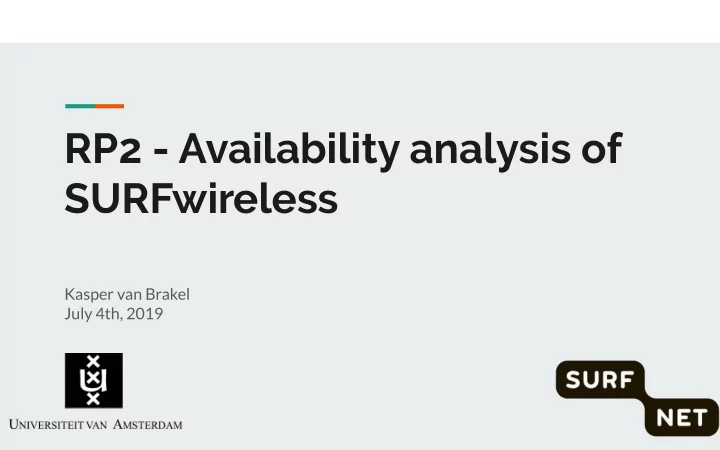

RP2 - Availability analysis of SURFwireless Kasper van Brakel July 4th, 2019
Introduction SURFwireless: Wi-Fi-as-a-Service since 2016 ● Aerohive, Hivemanager ● Investigate potential attacks that threaten the availability for clients of SURFwireless ● 2
Research questions How can SURFnet detect that the availability of the SURFwireless service is under threat and ● determine its impact? Sub-questions: ○ Which common attacks on 802.11 networks can be used to threaten the availability of SURFwireless? ○ What impact can these attack cause on the wireless clients of SURFwireless? ○ What measures can SURFnet take to defend SURFwireless against attacks on availability? 3
Scope Potential attacks must be applicable on 802.11 with WPA2-Enterprise ● The general security of eduroam is out of scope, only investigating attacks on availability ● Only detection and prevention methods of the attacks that can be configured from the ● Hivemanager were investigated 4
Related work Type of DoS attacks (Bicakci et al.): ● Radio Frequency(RF) jamming ○ MAC layer attacks ○ Above MAC layer attacks (protocol based i.e. ARP, ICMP, TCP ) ○ MAC layer Denial-of-Service(DoS) attacks: ● Deauthentication attack (Bellardo et al.) ○ Channel Switch attack (Könings et al.) ○ Quiet attack (Könings et al.) ○ 5
Experiments Parameters: iPerf3 and ping ● Experiments performed 30 times for 60 seconds ● Scapy ● Experiments: Basetest ● Deauthentication attack ● Channel Switch attack ● Quiet attack ● Figure 4: Testbed setup 6
Deauthentication attack Abuses deauth frames ● Figure 1: Generic Deauthentication frame. Source: 802.11 Wireless Networks: The Definitive Guide, Oreilly 7
Channel Switch attack Abuses 802.11h amendment ● Transmitted in Beacon, Probe response or action frame ● Figure 2: Generic Channel Switch element. Source: 802.11 Wireless Networks: The Definitive Guide, Oreilly 8
Quiet attack 802.11h amendment ● Transmitted in Beacons, Probe response ● Depending on driver implementation clients can be silenced for up to 65535 Time Units ● Figure 3: Quiet element. Source: 802.11 Wireless Networks: The Definitive Guide, Oreilly 9
10
11
12
13
14
15
Vulnerable devices Vulnerable against Deauthentication and Channel Switch attack ● Device 802.11 chip OS Dell XPS 13 Intel 6235-N Linux mint 2019.1 Macbook pro Airport card MacOS 10.14.5 (2017) Samsung S10 Broadcom Android 9 One Plus 6T Qualcomm Android 9 16
DoS Detection Alarm Threshold Alarm Threshold Type Client (frames per SSID (frames per minute) minute) Detection Probe Request 1200 12000 Probe Response 2400 24000 DoS protection by Aerohive ● (Re) Association 600 6000 Request Only deauthentication attack was ● detected Association 240 2400 Disassociation 120 1200 Authentication 600 6000 Deauthentication 120 1200 EAP Over LAN 600 6000 (EAPol) Table 1: Overview of default threshold values Hivemanager. 17
Detection Formula: ● Attack frame rate Clients 0.1 0.5 1 1.5 2 2.5 3 3.5 4 4.5 5 5.5 6 6.5 7 7.5 1 600 120 60 40 30 24 20 17.1 15 13.3 12 10.9 10 9.2 8.6 8 10 6000 1200 600 400 300 240 200 171 150 133 12 109 100 92 86 80 0 Table 2: Overview of threshold values for Hivemanager per investigated attack frame rate. 18
Code: Action type: 0 Spectrum management 1 QoS Prevention 2 DLS 3 Block Ack 802.11w protects: ● Robust action frames ○ 5 Radio Deauthentication frames ○ Dissasociation frames ○ 6 Fast BSS Transition Channel switch and Quiet attack can both abuse ● beacon and probe response frames ← not protected 8 SA Query 9 Protected Dual of Public Action 126 Vendor-specific Protected Table 3: Overview of robust action frames from 802.11 19 specification Source
Discussion SSID threshold not variable based on client count ● Quiet attack may potentially work on other devices ● More sophisticated detection methods to determine MAC address spoofing based attacks i.e. by ● sequence number exists (Guo et al). Source For 802.11w protection both client and AP must support it ● Attacks were conducted on a single access point environment ● 20
Conclusion Deauthentication attack and Channel Switch attack both succeeded ● Impact on the wireless clients depend on used attack frame rate ● Only the deauthentication attack was detected by Aerohive WiPs ● 802.11w protects against deauthentication attack, channel switch and quiet attack remain ● unaddressed 21
Future work Locate attacker, combining 802.11-based positioning and frame thresholds per AP ● Investigate other relevant attacks that potentially threaten the availability of SURFwireless and ● determine the threshold value for Aerohive WiPs. Investigate the possibility to extend the current 802.11w amendment to support all frames if client ● is authenticated. 22
Questions? 23
Recommend
More recommend